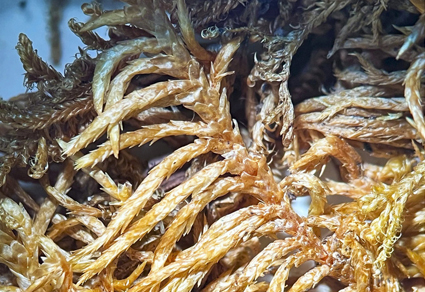Abstract
The moss flora of the state of Coahuila and that in northwestern Mexico is poorly known. Recent exploration in the drylands of Coahuila have yielded findings that bring the number to about 101 species in the state moss flora where the Pottiaceae, Bryaceae, and Grimmiaceae are the families best represented. The lowland moss flora is well represented in the Chihuahuan Desert area in northern Mexico, but also in the southern United States. Species of Crossidium, Pseudocrossidium, and Syntrichia are known desiccation-tolerant mosses; Entodon concinnus and Ephemerum coherens are additions to the moss flora of Mexico.
Downloads
Download data is not yet available.
References
- Bryan, V.S. (2007) Ephemeraceae Schimper. In: Flora of North America Editorial Committee, eds. Flora of North America North of Mexico 27: 646 ̶ 653.
- Buck, W.R. (1994) Entodontaceae. The moss flora of Mexico. Memoirs of the New York Botanical Garden 69: 948 ̶ 960.
- Buck, W. R. (2014) Entodontaceae Kindberg. In: Flora of North America Editorial Committee, eds. Flora of North America North of Mexico 28: 502 ̶ 507.
- Crum, H. (1951) The Appalachian-Ozarkian element in the moss flora of Mexico with a check-list of all known Mexican mosses. Ph.D. Dissertation. University of Michigan. Ann Arbor, 504 pp.
- Delgadillo, M.C., Bello, B. & Cárdenas, S.A. (1995) LATMOSS. A Catalogue of Neotropical Mosses. Monographs in Systematic Botany from the Missouri Botanical Garden 56: 1 ̶ 191.
- Flora of North America Editorial Committee (Eds.) (2014) Flora of North America North of Mexico. Vol. 28. New York and Oxford.
- Glime, J.M. (2017) Water Relations: Habitats. Chapt. 7-8. In: Glime, J.M. (Ed.) Bryophyte Ecology. Vol. 1. Physiological Ecology. Michigan Technological University and the International Association of Bryologists. Available from: http://digitalcommons.mtu.edu/bryophyte-ecology (accessed 7 June 2023)
- INEGI (2023) Consulta de indicadores sociodemográficos y económicos por área geográfica. Available from: https://inegi.org.mx/ (accessed 7 June 2023)
- Proctor, M.C.F., Oliver, M.J., Wood, A.J., Alpert, P., Stark, L.R., Cleavitt, N.L. & Mishler, B.D. (2007) Desiccation-tolerance in bryophytes: a review. The Bryologist 110: 595 ̶ 621. https://doi.org/10.1639/0007-2745(2007)110[595:DIBAR]2.0.CO;2
- Reed, S.C., Coe, K.K., Sparks, J.P., Housman, D.C., Zelikova, T.J. & Belnap, J. (2012) Changes to dryland rainfall result in rapid moss mortality and altered soil fertility. Nature Climate Change 2: 752 ̶ 755. https://doi.org/10.1038/nclimate1596
- Ríos-Meléndez, S., Valadez-Hernández, E., Delgadillo C., Luna-Guevara, María Luisa, Martínez-Núñez, Mario A., Sánchez-Pérez, M., Martínez-y-Pérez, J.L., Arroyo-Becerra, A., Cárdenas, L., Bibbins-Martínez, M., Maldonado-Mendoza, I.E. & Villalobos-López, M.A. (2021). Pseudocrossidium replicatum (Taylor) R. H. Zander is a fully desiccation-tolerant moss that expresses an inducible molecular mechanism in response to severe abiotic stress. Plant Molecular Biology 107: 387 ̶ 404. https://doi.org/10.1007/s11103-021-01167-3
- Sharp, A.J., Crum, H. & Eckel, P.M. (1994) The moss flora of Mexico. Memoirs of the New York Botanical Garden 69: 1 ̶ 1111.
- Stark, L.R. (2005) Phenology of patch hydration, patch temperature and sexual reproductive output in the desert moss Crossidium crassinerve. Journal of Bryology 27: 231 ̶ 240. https://doi.org/10.1179/174328205X69977


